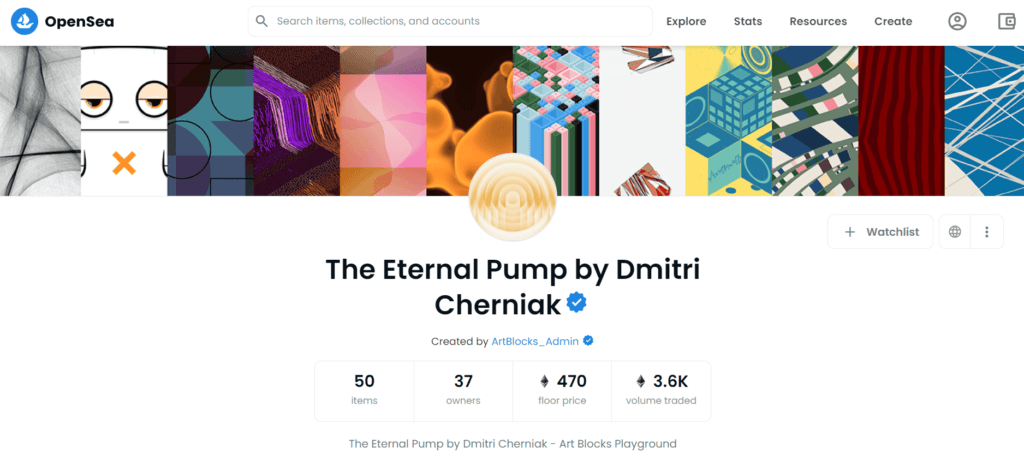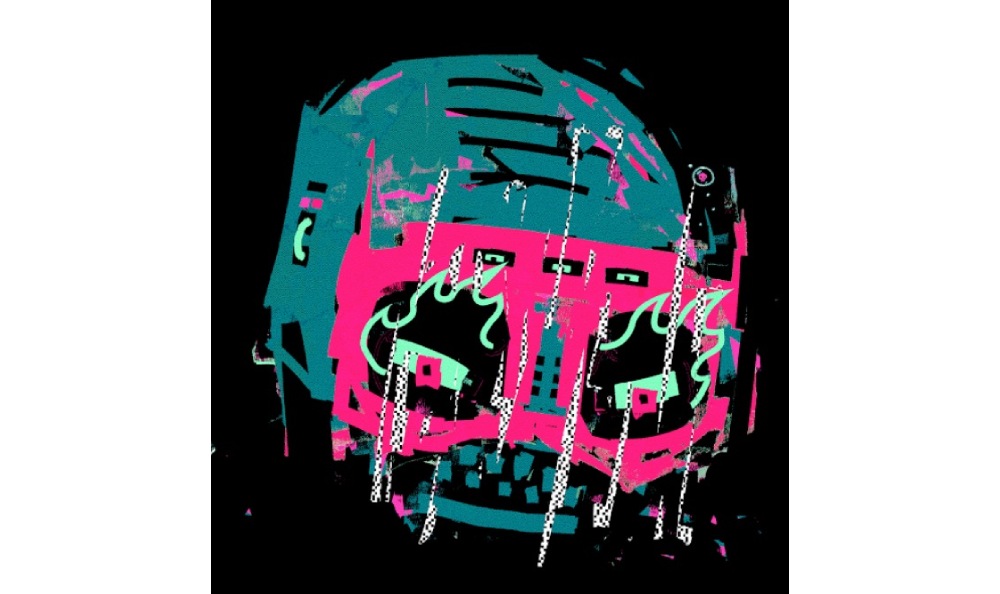Discover examples of some of the best generative artists from history.
Generative art is an algorithmic recreation of reality according to procedures and parameters set by the artist. That’s why it’s also referred to as procedurally generated art, algorithmic art, or AI generative art.
The widespread availability of software engines and computer programs capable of procedural generation of data in the 21st century has given rise to a world of algorithmic art in bloom. And the burgeoning of the blockchain and NFTs this decade has added fuel to the fire.
But generative art began to dawn in the 20th century with the advent of the computer era, with inklings of the future possibilities of digital computation here and there in earlier centuries. For instance, the famous architect, Frank Lloyd Wright’s stained glass patterns and visual artwork are reminiscent of the work of contemporary generative artists.
Table of Contents
How Generative Artists Make Art
A generative artist can procedurally create a work with a pen and some sheets of computer paper, and the help of a few friends. Just give each friend a sheet of paper and have them mark a dot or two at random without looking at each other’s marks.
Then take one sheet of paper and put a dot where each of your friends did on their sheet. Then draw gradually widening concentric circles around each dot. The circles can intersect each other, or when they’re about to, you can draw around the new shape the meeting circles create together.
That is in a nutshell how the computer algorithm does it. Just add another rule or two, another idea or two to this process, and this simple procedure for generating patterns will erupt into a riot of visual brilliance and energy. These days, some of the best NFT artists use computer software and coding techniques to create unique artworks that exist on the Ethereum (and other) blockchains.
The following list is hardly comprehensive, with new generative artists arriving on the scene all the time. Yet thesese generative artists on this list deserve mention.
1. Bob Ross
“You can draw in some basic shapes. And if you’ve never seen the Northern Lights, a lot of times, they’re in what you call curtains. Or just layers.” -Bob Ross, Northern Lights (Season 8 Episode 13 The Joy of Painting)
The magic of the hit television show, The Joy of Painting was how Bob Ross was able to impart to viewers simple procedures of pattern iteration that would generate beautiful, stoic, natural landscapes. His method was so simple, that even a computer algorithm could do it.
“Now, decide where these curtains or these lights are going to be, and just begin tapping. You see? All I’m doing is just tapping. Tapping the color in. Make your basic shapes. Just very basic shapes.” (Ibid.)
Many of his fans found that with no previous experience, they could create wonderful paintings by following along. Bob Ross was a generative artist without a computer. He found a way to do it with a canvass and brush because that was the only way he could.
2. Tom Baccei, Creator of Magic Eye
The Magic Eye books were one of the beloved crazes of the 1990s, in the same league as Game Boy and Beanie Babies. In 1991, West Fairlee, Vermont native, Tom Baccie’s optical illusion books became an overnight bestseller in Japan, and soon the rest of the world.
He studied math at the University of Connecticut. But he described his studies as, “modern algebra, sets, and groups, layers of abstraction that built on each other,” a fair description of what generative artists do with computer algorithms to create their works of art.
The technical term for the Magic Eye illusion is an autostereogram. Baccie’s method of creating them involved procedural generation. Beginning with an initial pattern on a strip, he generated the images using a depth map to produce a random dot autostereogram.
3. Mad Dog Jones

“Mad Dog Jones” —Micah Dowbak of Ontario, Canada, is one of the best-selling NFT generative artists of all time. The scope of his work and the power and reach of the Ethereum blockchain has propelled Dowbak to international acclaim in the digital art world.
His talent for digital illustration is only part of what makes Mad Dog Jones’ work so compelling to the blockchain and art communities. The other key ingredient to the success that made him the selling artist in Canada’s history is how he has used programmable smart tokens to add some fun and quirky randomness, turning his NFTs into generative art.
For example, his claim to fame, The REPLICATOR, an NFT that sold for millions of dollars, generates new versions of itself every 28 days with new, unique designs and attributes.
But that’s not all— the blockchain artwork depicting a 20th-century fax machine telecopier is intentionally programmed to glitch. So the generative process is algorithmically designed to not be perfect, but to be imperfect, the way DNA transcription in life is imperfect, giving rise to the mutations that have made life on earth so splendorous in its variation and diversity.
Learn more about Mad Dog Jones
4. David Brewster, Creator of the Kaleidoscope
David Brewster was an early 19th-century scientist and inventor. He made pioneering innovations in photography and stereoscopes. He’s also famous for inventing one of the earliest seminal devices in the history of generative artists, the kaleidoscope.
Brewster was highly regarded in the academic community of his day and received several prestigious awards and honors. But he became famous among the general, non-scientific public for the kaleidoscope, which set off a craze in England, France, and the United States in the 1810s.
Though he obtained a patent for the invention, Brewsteer demonstrated the neat gadget to opticians before getting the patent. Subsequently, it was mass-produced to satisfy raging popular demand for the device that made anyone who held it a generative artist with each turn of the scope.
The fixation on kaleidoscopes in the Victorian era was something akin to the way the iPhone transfixed people when it went on sale in the early 21st century.
5. Dimitri Cherniak

Born in 1988 and in Canada, Dimitri Cherniak is a popular NFT generative artist. He espouses on Twitter that automation is his media and art his code. He is best known for his generative art NFT project The Eternal Pump.
His other generative artworks regularly auction or sell for six and sometimes seven figures. One example is The difference between the subtleties and the subtleties which Sotheby’s auctioning for between one and one point five million dollars.
6. Xcopy

XCOPY is a pseudonym for one of the prolific NFT generative artists. He develops dystopian, animated NFTs that sell for six and seven figures in Ethereum.
Collectors can either mint their NFTs on sites such as SuperRare and Nifty Gateway, or purchase them on OpenSea’s secondary market. Cryptoart claims to have sold 1,918 NFTS worth a total of $52,228,445.35. (16,923.934 ETH).
Right-click and Save is a popular XCOPY digital artwork. Snoop Dog purchased it in December 2021 for around $7 million. More recently, he released the Max Pain and Friends Collection.
7. Frieder Nake
Frieder Nake is a 20th-century generative artist who pioneered creating digital art using artificial intelligence and algorithms in the mid-1960s.
As a computer science expertNake started using autonomous systems to create large amounts of digital art alongside the renowned artist Georg Nees.
Nake and Nees first displayed their generative artworks at the Galerie Wendelin Niedlich in Stuttgart in 1965. The exhibition was the first time for the art world and arguably got the computer art ball rolling.
Nake developed a basic software system known as Zuse Graphomat Z64 that was used for flatbed plotter art, considered one of the earliest forms of generative art.
Even though Nake was one of the first to create generative designs using computers, he questioned the field. For example, in 1971, he wrote a controversial piece for the Computer Arts Society (CAR) titled ‘There Should Be No Computer Art.’
Nake’s CAR piece argued the role of computers in creating unemployment through automation and its increasing role in warfare meant they should not play such a pivotal role in the arts.
The CAR article ignited a debate among artists, but it didn’t stem the rise of generative art throughout the late 20th century.
8. Casey Reas
Casey Reas is known for creating an open-source processing programming language that was later adopted by thousands of digital artists who use it to create generative artworks.
Casey documented his insights into the generative art field in his book titled Generative Adversarial Networks. The generative systems used by Casey utilize short-coded instructions to generate iterations of static and dynamic graphics.
Casey’s work has been exhibited worldwide, from the Bitforms gallery in New York to the Sonar festival in Barcelona.
Casey has become increasingly involved in the NFT space and often comments on posts about the ecosystem and NFT works of art that catch his eye on Twitter.
Although most digital artists in the NFT space opt for the Ethereum (ETH) blockchain, Casey is known to use the Tezos chain. You can check out Casey’s Tezos (XTZ) NFTs by visiting his official fxhash.xyz page.
Some of Casey’s most notable recent NFT mints include the Century-XXX-METAMORELLET and Century-XXX-METARILEY.
If you want to learn more about the Tezos blockchain, take a look at our article that covers the Top 8 Tezos NFT Projects.
9. Vera Molnar
Vera Molnar is widely considered to be the first female computer artist, she was born in 1924 in Hungary, and much like Frieder Nake, she is responsible for laying the groundwork for the generative art world.
In 1960 she co-founded the Groupe de recherche d’art visuel (GRAV), which bought together a group of revered artists that focused on kinetic art.
As the power of personal computers improved into the 1970s, Molnar latched onto their potential in the art field and developed the Molnart computer program.
Molnart generated art by randomizing geometric shapes based on predetermined rules – a precursor to today’s more complex generative art algorithms.
Molnar’s contribution to the digital art field was honored in 2005 when she received the Dam Digital Art Award (DDAA) for her historic contribution to the art form.
10. SnowFro

Erick Calderon, better known online as ‘SnowFro’, is the mastermind behind Art Blocks, an Ethereum-based program launched in 2020 and is used by countless digital artists to create generative art.
The programmers behind Art Blocks designed it always to create unique pieces of artwork while allowing artists to pick different styles for the algorithms to express.
Art Blocks asks artists to upload their algorithms to the site and set how many tokens they want to mint; once the transactions are settled, the digital art is generated as an ERC-721 token on Ethereum.
SnowFro’s first project on Art Blocks was the ‘Chromie Squiggle’ collection of 10,000 unique multi-colored squiggles.
The eye-catching Sqiggles have been an enormous success both for the Art Blocks platform and SnowFro himself, with the rarest tokens selling for well over 1$ million.
11. Tyler Hobbs
Tyler Hobbs is a visual artist and computer science graduate focusing on using plotters and machine learning within the cryptoart space. According to Hobbs’ website, he programs his own algorithms to create visual imagery that relates to the natural world’s chaos. He has collaborated with the Art Blocks platform and personally launched the site’s most successful project, known as the ‘Fidenza’ series.
The Fidenza collection of 999 NFTs is named after an Italian town, and each token is inspired by Franz Kline, an American artist who played a significant role in the abstract expressionist movement in the 1940s and 50s.
The Fidenza collection was built on a flow field algorithm that generates organic curves that run parallel to each other in an unpredictable direction.
The flow field algorithm generated curved structures and blocks into stunning colorful patterns that flow across the plain background in an awe-inspiring design, and the pieces regularly sell for over $200,000.
If you’re interested what a Fidenza looks like, check out Hobbs’ OpenSea profile, and to see discover more of his collections, take a look at his portfolio.
If you like this article, you may also enjoy our guide to the best NFT artists to follow

